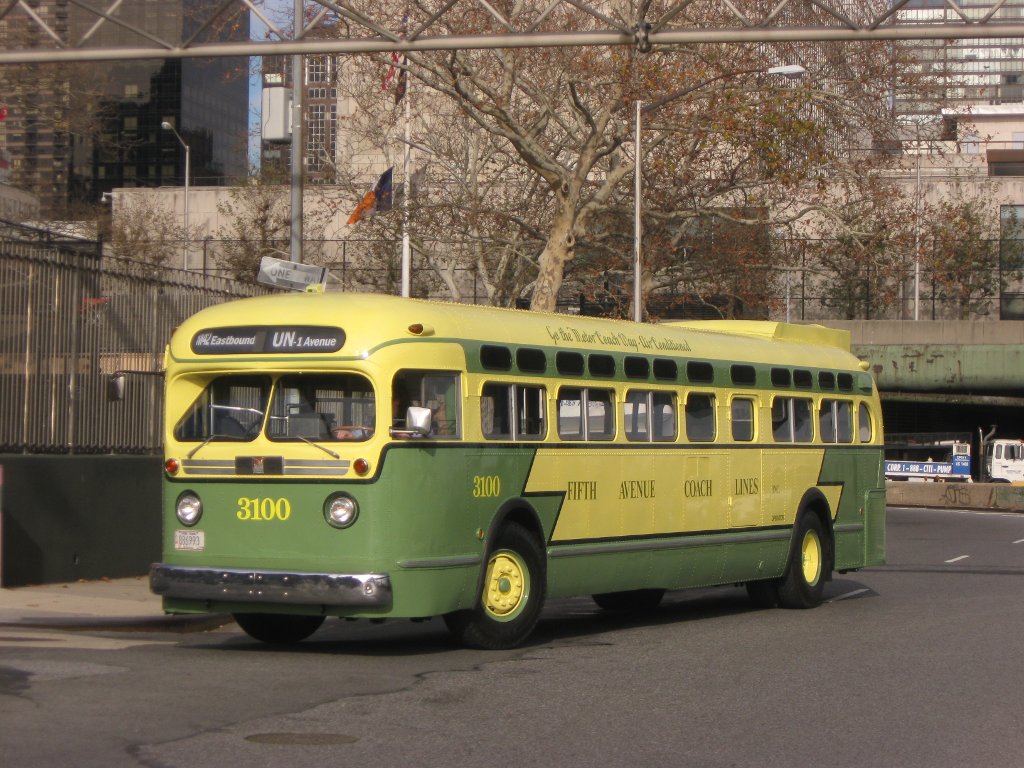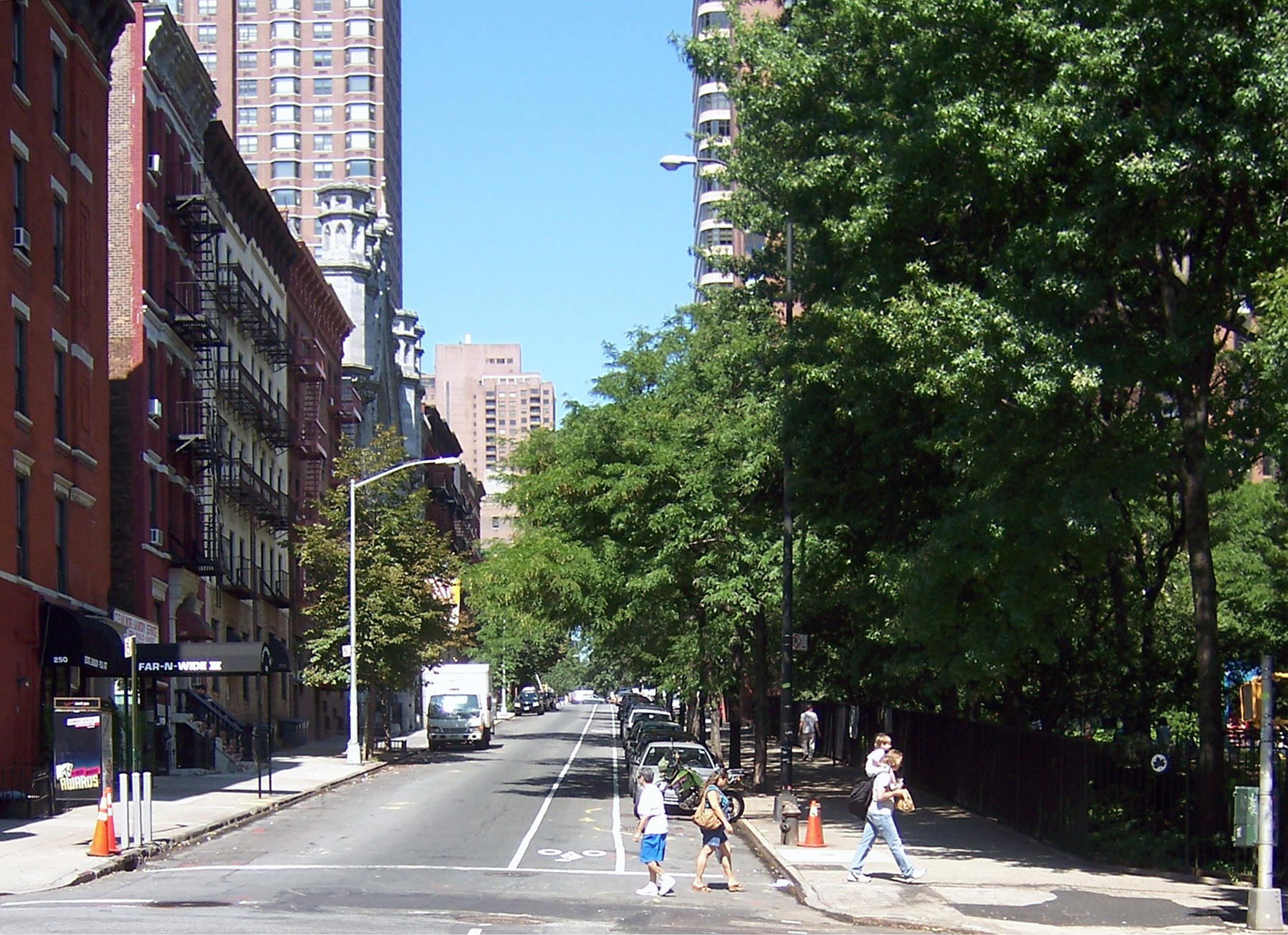|
New York City Omnibus Corporation
The New York City Omnibus Corporation (NYCO, later Fifth Avenue Coach Lines, Inc.) ran bus services in New York City between 1926 and 1962. It expanded in 1935/36 with new bus routes to replace the New York Railways Corporation streetcars when these were dismantled. It further expanded with the acquisition of the Fifth Avenue Coach Company from The Omnibus Corporation in 1954. NYCO was renamed the "Fifth Avenue Coach Lines, Inc." in 1956, becoming bankrupt in 1962, after which operations were taken over by the Manhattan and Bronx Surface Transit Operating Authority. History The New York City Omnibus Corporation was formed in 1926 with John A. Ritchie as President. Richie was also president of The Omnibus Corporation founded a year earlier. The company introduced new bus lines to replace the streetcar lines being withdrawn by the New York Railways Corporation in 1935/36, which The Omnibus Corporation also owned. In 1954, the company purchased the Fifth Avenue Coach Company from ... [...More Info...] [...Related Items...] OR: [Wikipedia] [Google] [Baidu] |
New York City
New York, often called New York City or NYC, is the List of United States cities by population, most populous city in the United States. With a 2020 population of 8,804,190 distributed over , New York City is also the List of United States cities by population density, most densely populated major city in the United States, and is more than twice as populous as second-place Los Angeles. New York City lies at the southern tip of New York (state), New York State, and constitutes the geographical and demographic center of both the Northeast megalopolis and the New York metropolitan area, the largest metropolitan area in the world by urban area, urban landmass. With over 20.1 million people in its metropolitan statistical area and 23.5 million in its combined statistical area as of 2020, New York is one of the world's most populous Megacity, megacities, and over 58 million people live within of the city. New York City is a global city, global Culture of New ... [...More Info...] [...Related Items...] OR: [Wikipedia] [Google] [Baidu] |
Central Park South
59th Street is a crosstown street in the New York City borough (New York City), borough of Manhattan, running from York Avenue and Sutton Place on the East Side (Manhattan), East Side of Manhattan to the West Side Highway on the West Side (Manhattan), West Side. The three-block portion between Columbus Circle and Grand Army Plaza (Manhattan), Grand Army Plaza is known as Central Park South, since it forms the southern border of Central Park. The street is mostly continuous, except between Ninth Avenue (Manhattan), Ninth Avenue/Columbus Avenue (Manhattan), Columbus Avenue and Columbus Circle, where the Time Warner Center is located. While Central Park South is a bidirectional street, most of 59th Street carries one-way traffic. 59th Street forms the border between Midtown Manhattan and Upper Manhattan. North of 59th Street, the neighborhoods of the Upper West Side and Upper East Side continue on either side of Central Park. On the West Side (Manhattan), West Side, Manhattan's numb ... [...More Info...] [...Related Items...] OR: [Wikipedia] [Google] [Baidu] |
The Omnibus Corporation
The Omnibus Corporation (also Omnibus Corporation of America) is an American bus company that was formed in 1924 and acquired control of Fifth Avenue Coach Company and the Chicago Motor Coach Company with John D. Hertz as chairman. In 1953, it purchased Yellow Drive-It-Yourself from General Motors and sold its interests in public transport. The following year the company was renamed The Hertz Corporation and was floated on the New York Stock Exchange. History John D. Hertz formed the Omnibus Corporate in 1924 as a merger of the Chicago Motor Coach and the Fifth Avenue Motor Coach Corporation of New York City.Chicago Motor Coach Co. ''The Electronic Encyclopedia of Chicago'' © 2005 Chicago Historical Society Between 1925 and 1936, The Omnibus Corporation acquired streetcar companies that operated on |
Fifth Avenue Coach Company
The Fifth Avenue Coach Company was a bus operator in Manhattan, The Bronx, Queens, and Westchester County, New York, providing public transit between 1896 and 1954 after which services were taken over by the New York City Omnibus Corporation. It succeeded the Fifth Avenue Transportation Company. History The company was founded in 1896 when it succeeded the bankrupt Fifth Avenue Transportation Company. It initially operated existing horse-and-omnibus transit along Fifth Avenue, with a route running from 89th Street to Bleecker Street. Fifth Avenue is the only avenue in Manhattan never to see streetcar service due to the opposition of residents to the installation of railway track for streetcars. The company introduced electric buses two years later and was acquired by the newly formed New York Transportation Company in 1899. They introduced a fleet of 15 of their own motorbuses in 1907 that operated along Fifth Avenue and on some crosstown routes. The company became independe ... [...More Info...] [...Related Items...] OR: [Wikipedia] [Google] [Baidu] |
New York Railways Corporation
The New York Railways Corporation was a railway company that operated street railways in Manhattan, New York City, United States between 1925 and 1936. During 1935/1936 it converted its remaining lines to bus routes which were operated by the New York City Omnibus Corporation, and now operated by the Manhattan and Bronx Surface Transit Operating Authority. The organization was the successor to the New York Railways Company which was in receivership. History The New York Railways Corporation took over operations from the receivers of the New York Railways Company on May 1, 1925. A majority of stock was bought in August 1926 by the Fifth Avenue Coach Company which had been acquired by the newly formed The Omnibus Corporation the same year. It was reported at the time that the company had plans to abandon the lines and replace them with buses operated by the newly formed New York City Omnibus Corporation. The Eighth and Ninth Avenue Railroads merged in December 1926 to form the Eig ... [...More Info...] [...Related Items...] OR: [Wikipedia] [Google] [Baidu] |
Astoria, Queens
Astoria is a neighborhood in the western portion of the New York City borough of Queens. Astoria is bounded by the East River and is adjacent to three other Queens neighborhoods: Long Island City to the southwest, Sunnyside to the southeast, and Woodside to the east. , Astoria has an estimated population of 95,446. The area was originally called Hallet's (or Hallett's) Cove after its first landowner William Hallet, who settled there in 1652 with his wife, Elizabeth Fones. Hallet's Cove was incorporated on April 12, 1839, and was later renamed for John Jacob Astor, then the wealthiest man in the United States, in order to persuade him to invest in the area. During the second half of the 19th century, economic and commercial growth brought increased immigration. Astoria and several other surrounding villages were incorporated into Long Island City in 1870, which in turn was incorporated into the City of Greater New York in 1898. Commercial activity continued through the 20 ... [...More Info...] [...Related Items...] OR: [Wikipedia] [Google] [Baidu] |
Randalls And Wards Islands
Randalls Island (sometimes called Randall's Island) and Wards Island are conjoined islands, collectively called Randalls and Wards Islands, in New York County, New York City,Feature Detail Report for Randalls Island "Purchased in 1772 by British Captain James Montresor; sold in 1784 to Johnathan Randel; acquired by City of New York in 1835." separated from by the , from by the < ... [...More Info...] [...Related Items...] OR: [Wikipedia] [Google] [Baidu] |
Yorkville, Manhattan
Yorkville is a neighborhood in the Upper East Side of Manhattan, New York City. Its southern boundary is East 72nd Street, its northern East 96th Street, its western Third Avenue, and its eastern the East River. Yorkville is among the city's most affluent neighborhoods. Yorkville is part of Manhattan Community District 8, and its primary ZIP Codes are 10028, 10075, and 10128. It is patrolled by the 19th Precinct of the New York City Police Department. History Early history Pre-colonization, Yorkville was an undeveloped area of forests and streams. In August 1776, George Washington stationed half of his Continental Army in Manhattan and the other half in Brooklyn. Many troops in the Yorkville area on Manhattan's Upper East Side were in defensive positions along the East River to protect a possible retreat off Long Island, and to inflict damage on invading land and sea British forces. Following their August 27 defeat in the Battle of Long Island, the Continentals implement ... [...More Info...] [...Related Items...] OR: [Wikipedia] [Google] [Baidu] |
Murray Hill, Manhattan
Murray Hill is a neighborhood on the east side of Manhattan in New York City. Murray Hill is generally bordered to the east by the East River or Kips Bay and to the west by Midtown Manhattan, though the exact boundaries are disputed. Murray Hill is situated on a steep glacial hill that peaked between Lexington Avenue and Broadway. It was named after Robert Murray, the head of the Murray family, a mercantile family that settled in the area in the 18th century. The Murray farm was formed before 1762 and existed until at least the early 19th century. Through the 19th century, Murray Hill was relatively isolated from the rest of New York City, which at the time was centered in Lower Manhattan. Murray Hill became an upscale neighborhood during the 20th century. Today, it contains several cultural institutions such as the Morgan Library & Museum, as well as missions and consulates to the nearby United Nations headquarters. The neighborhood also contains architectural landmarks, some ... [...More Info...] [...Related Items...] OR: [Wikipedia] [Google] [Baidu] |
Kips Bay, Manhattan
Kips Bay, or Kip's Bay, is a neighborhood on the east side of the New York City borough of Manhattan. It is roughly bounded by East 34th Street to the north, the East River to the east, East 27th and/or 23rd Streets to the south, and Third Avenue to the west. Kips Bay is part of Manhattan Community District 6, and its primary ZIP Codes are 10010 and 10016. It is patrolled by the 13th and 17th Precincts of the New York City Police Department. Geography According to ''The Encyclopedia of New York City'' and the New York City Department of City Planning, Kips Bay proper is generally bounded by East 34th Street to the north, the East River to the east, East 27th Street to the south, and Third Avenue to the west. City documents have also used New York City census tract 70 (from 29th to 34th Streets, First to Third Avenues) as an approximation for Kips Bay, and referred to tract 66, immediately below it, as "Bellevue South."See alsDraft Scoping Document for an Environmental Im ... [...More Info...] [...Related Items...] OR: [Wikipedia] [Google] [Baidu] |
Lower East Side
The Lower East Side, sometimes abbreviated as LES, is a historic neighborhood in the southeastern part of Manhattan in New York City. It is located roughly between the Bowery and the East River from Canal to Houston streets. Traditionally an immigrant, working-class neighborhood, it began rapid gentrification in the mid-2000s, prompting the National Trust for Historic Preservation to place the neighborhood on their list of America's Most Endangered Places in 2008. The Lower East Side is part of Manhattan Community District 3, and its primary ZIP Code is 10002. It is patrolled by the 7th Precinct of the New York City Police Department. Boundaries The Lower East Side is roughly bounded by East 14th Street on the north, by the East River to the east, by Fulton and Franklin Streets to the south, and by Pearl Street and Broadway to the west. This more extensive definition of the neighborhood includes Chinatown, the East Village, and Little Italy. A less extensive definit ... [...More Info...] [...Related Items...] OR: [Wikipedia] [Google] [Baidu] |






